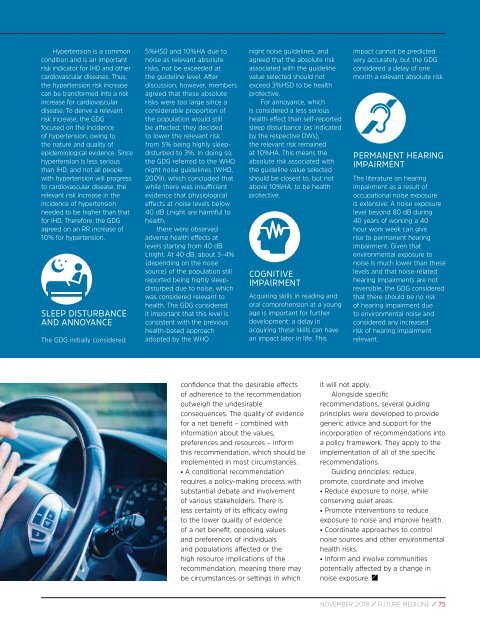Create successful ePaper yourself
Turn your PDF publications into a flip-book with our unique Google optimized e-Paper software.
Hypertension is a common<br />
condition and is an important<br />
risk indicator for IHD and other<br />
cardiovascular diseases. Thus,<br />
the hypertension risk increase<br />
can be transformed into a risk<br />
increase for cardiovascular<br />
disease. To derive a relevant<br />
risk increase, the GDG<br />
focused on the incidence<br />
of hypertension, owing to<br />
the nature and quality of<br />
epidemiological evidence. Since<br />
hypertension is less serious<br />
than IHD, and not all people<br />
with hypertension will progress<br />
to cardiovascular disease, the<br />
relevant risk increase in the<br />
incidence of hypertension<br />
needed to be higher than that<br />
for IHD. Therefore, the GDG<br />
agreed on an RR increase of<br />
10% for hypertension.<br />
SLEEP DISTURBANCE<br />
AND ANNOYANCE<br />
The GDG initially considered<br />
5%HSD and 10%HA due to<br />
noise as relevant absolute<br />
risks, not be exceeded at<br />
the guideline level. After<br />
discussion, however, members<br />
agreed that these absolute<br />
risks were too large since a<br />
considerable proportion of<br />
the population would still<br />
be affected; they decided<br />
to lower the relevant risk<br />
from 5% being highly sleepdisturbed<br />
to 3%. In doing so,<br />
the GDG referred to the WHO<br />
night noise guidelines (WHO,<br />
2009), which concluded that<br />
while there was insufficient<br />
evidence that physiological<br />
effects at noise levels below<br />
40 dB Lnight are harmful to<br />
health,<br />
there were observed<br />
adverse health effects at<br />
levels starting from 40 dB<br />
Lnight. At 40 dB, about 3–4%<br />
(depending on the noise<br />
source) of the population still<br />
reported being highly sleepdisturbed<br />
due to noise, which<br />
was considered relevant to<br />
health. The GDG considered<br />
it important that this level is<br />
consistent with the previous<br />
health-based approach<br />
adopted by the WHO<br />
night noise guidelines, and<br />
agreed that the absolute risk<br />
associated with the guideline<br />
value selected should not<br />
exceed 3%HSD to be health<br />
protective.<br />
For annoyance, which<br />
is considered a less serious<br />
health effect than self-reported<br />
sleep disturbance (as indicated<br />
by the respective DWs),<br />
the relevant risk remained<br />
at 10%HA. This means the<br />
absolute risk associated with<br />
the guideline value selected<br />
should be closest to, but not<br />
above 10%HA, to be health<br />
protective.<br />
COGNITIVE<br />
IMPAIRMENT<br />
Acquiring skills in reading and<br />
oral comprehension at a young<br />
age is important for further<br />
development: a delay in<br />
acquiring these skills can have<br />
an impact later in life. This<br />
impact cannot be predicted<br />
very accurately, but the GDG<br />
considered a delay of one<br />
month a relevant absolute risk.<br />
PERMANENT HEARING<br />
IMPAIRMENT<br />
The literature on hearing<br />
impairment as a result of<br />
occupational noise exposure<br />
is extensive. A noise exposure<br />
level beyond 80 dB during<br />
40 years of working a 40<br />
hour work week can give<br />
rise to permanent hearing<br />
impairment. Given that<br />
environmental exposure to<br />
noise is much lower than these<br />
levels and that noise-related<br />
hearing impairments are not<br />
reversible, the GDG considered<br />
that there should be no risk<br />
of hearing impairment due<br />
to environmental noise and<br />
considered any increased<br />
risk of hearing impairment<br />
relevant.<br />
confidence that the desirable effects<br />
of adherence to the recommendation<br />
outweigh the undesirable<br />
consequences. The quality of evidence<br />
for a net benefit – combined with<br />
information about the values,<br />
preferences and resources – inform<br />
this recommendation, which should be<br />
implemented in most circumstances.<br />
• A conditional recommendation<br />
requires a policy-making process with<br />
substantial debate and involvement<br />
of various stakeholders. There is<br />
less certainty of its efficacy owing<br />
to the lower quality of evidence<br />
of a net benefit, opposing values<br />
and preferences of individuals<br />
and populations affected or the<br />
high resource implications of the<br />
recommendation, meaning there may<br />
be circumstances or settings in which<br />
it will not apply.<br />
Alongside specific<br />
recommendations, several guiding<br />
principles were developed to provide<br />
generic advice and support for the<br />
incorporation of recommendations into<br />
a policy framework. They apply to the<br />
implementation of all of the specific<br />
recommendations.<br />
Guiding principles: reduce,<br />
promote, coordinate and involve<br />
• Reduce exposure to noise, while<br />
conserving quiet areas.<br />
• Promote interventions to reduce<br />
exposure to noise and improve health.<br />
• Coordinate approaches to control<br />
noise sources and other environmental<br />
health risks.<br />
• Inform and involve communities<br />
potentially affected by a change in<br />
noise exposure.<br />
<strong>NOVEMBER</strong> <strong>2018</strong> / FUTURE MEDICINE / 75


















